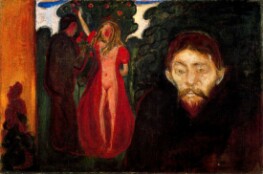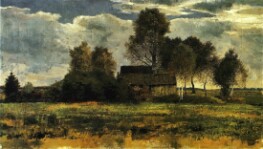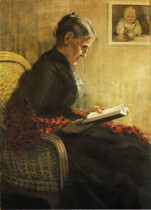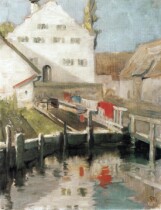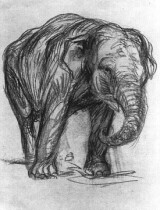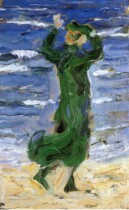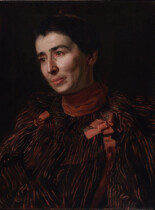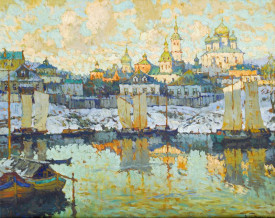The Fate of the Animals
Fate of the Animals is an apocalyptic vision that reflected the atmosphere before the outset of World War I. On the back of the canvas, Marc placed an inscription: “And All Being is Flaming Suffering.” Like this inscription, the vision is a chaotic scene where the animals flee in terror from the flames. Through the use of diagonals, Marc constructed a very severe and organized composition, which provided balance and order to a scene of confusion and chaos. At the same time, the diagonals add to the tension and intensity of the painting by emphasizing the contrast between the tones of blue, red, and green.
Marc created the painting sometime before May 1913, and originally titled it The Trees Show Their Rings, The Animals Their Veins. However, following the advice of friend and artist, Paul Klee, he changed the name to Fate of the Animals. After Marc’s death, the painting was part of a memorial exhibition at the Sturm Gallery in Berlin. Subsequently, a fire broke out in the storage space of the gallery and damaged parts of the painting. Paul Klee worked on the restorations, and while he restored the linear structure of the painting, he did not try to replicate Marc’s color scheme. In the restored section on the right, the somber brownish tones lack the vitality and brightness of Marc’s original coloring. Following the restoration, the painting was purchased for the Moritzburg Museum in Halle. In 1936, it was confiscated by the Nazi Party, that labeled modern art as ‘degenerate art’. The painting resurfaced in 1939 when it was auctioned off with other confiscated works and bought by the Basel Kunstmuseum, where it still resides.
Marc’s vision of horror and destruction merged several sources of inspiration. Stylistically, Marc created a synthesis of elements from several art movements of the period: cubistic structures, futuristic ‘lines of force,’ and color treatment inspired by Orphism, which was developed by painters Robert and Sonya Delaunay. The natural elements in the painting were probably inspired by ancient Nordic myths, which were popularized by German philosopher Friedrich Nietzsche and composer Richard Wagner. For example, the central motif of the tree relates to Yggdrasil, a giant world-ash tree that nourishes all spiritual and physical life in ancient Nordic cosmology. As such, the tree might be providing shelter and protection to the group of animals hiding on the right. In terms of subject, Marc’s apocalyptic image is linked to a story by French novelist, Gustav Flaubert, The Legend of Saint Julian the Hospitalier. Marc admired Flaubert, and just before Fate of the Animals, he painted St. Julian the Hospitaler (1913). In the story and Marc’s painting, Julian creates havoc and destruction, and his victims are animals. However, the destruction is necessary because it ultimately instigates Julian’s purification and redemption. Similarly, pre-war Expressionists, like Marc, believed that the corrupt and soulless society they lived in could only be reformed through radical change or destruction. This idea also manifests itself in Fate of the Animals: it is an apocalyptic vision that can lead to man’s redemption.
